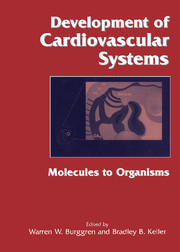Book contents
- Frontmatter
- Contents
- List of contributors
- Foreword by Constance Weinstein
- Introduction: Why study cardiovascular development?
- Part I Molecular, cellular, and integrative mechanisms determining cardiovascular development
- 1 Genetic dissection of heart development
- 2 Cardiac membrane structure and function
- 3 Development of the myocardial contractile system
- 4 Vasculogenesis and angiogenesis in the developing heart
- 5 Extracellular matrix maturation and heart formation
- 6 Endothelial cell development and its role in pathogenesis
- 7 Embryonic cardiovascular function, coupling, and maturation: A species view
- 8 Hormonal systems regulating the developing cardiovascular system
- Part II Species diversity in cardiovascular development
- Part III Environment and disease in cardiovascular development
- Epilogue: Future directions in developmental cardiovascular sciences
- References
- Systematic index
- Subject index
5 - Extracellular matrix maturation and heart formation
from Part I - Molecular, cellular, and integrative mechanisms determining cardiovascular development
Published online by Cambridge University Press: 10 May 2010
- Frontmatter
- Contents
- List of contributors
- Foreword by Constance Weinstein
- Introduction: Why study cardiovascular development?
- Part I Molecular, cellular, and integrative mechanisms determining cardiovascular development
- 1 Genetic dissection of heart development
- 2 Cardiac membrane structure and function
- 3 Development of the myocardial contractile system
- 4 Vasculogenesis and angiogenesis in the developing heart
- 5 Extracellular matrix maturation and heart formation
- 6 Endothelial cell development and its role in pathogenesis
- 7 Embryonic cardiovascular function, coupling, and maturation: A species view
- 8 Hormonal systems regulating the developing cardiovascular system
- Part II Species diversity in cardiovascular development
- Part III Environment and disease in cardiovascular development
- Epilogue: Future directions in developmental cardiovascular sciences
- References
- Systematic index
- Subject index
Summary
Introduction
The extracellular matrix (ECM) provides a structural framework for the formation of the complex 3-dimensional organization of tissues of the body. The ECM ranges from little more than a fluid medium to a rather rigid scaffolding. The composition and organization of the ECM are very dynamic in most tissues, particularly during embryogenesis, wound repair, and some disease states (Borg & Terracio, 1990; Borg & Burgess, 1993). Cellular interactions with the ECM influence a diverse array of processes not only through the ECM's role as a physical scaffold but also through specific signal transduction mechanisms (see Hynes, 1992, and Juliano & Haskill, 1993, for reviews).
The ECM of the heart is intimately associated with development and maintenance of heart structure and function. The heart ECM is composed of collagens, particularly types I, III, IV, and VI, proteoglycans, and noncollagenous glycoproteins such as laminin and fibronectin (Table 5.1; see also Kitten, Markwald, & Bolender, 1987; Borg & Terracio, 1990; Bashey, Martinez-Hernandez, & Jiminez, 1992; Borg & Burgess, 1993; Carver, Terracio, & Borg, 1993). These ECM components are expressed in precise temporal and spatial patterns in the developing and mature heart (see, e.g., Little et al., 1989; Iruela-Arispe & Sage, 1991; Sinning, Krug, & Markwald, 1992; Zagris, Stavridis, & Chung, 1993). Laminin, for example, appears localized to basement membranes of specific cells of the developing embryo and is particularly abundant in the heart (Figure 5.1). Laminin continues to be localized to the basement membranes associated with cardiomyocytes and vessels in the ventricular wall in the mature heart (Figure 5.1C). Expression of laminin is altered during cardiovascular development and with disease (Lipke et al., 1993).
- Type
- Chapter
- Information
- Development of Cardiovascular SystemsMolecules to Organisms, pp. 43 - 56Publisher: Cambridge University PressPrint publication year: 1998
- 1
- Cited by



